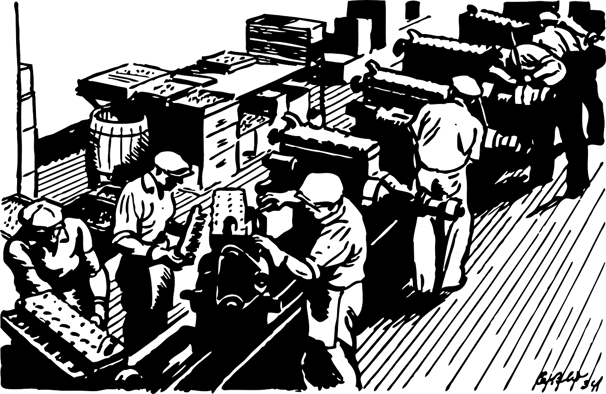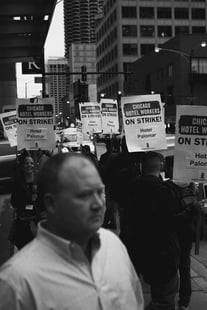
Henry Ford, not the US Labor Bureau, instituted the first major increase in the minimum wage. In January 1914, Henry started paying his auto workers a remarkable $5 a day. Doubling the average wage helped ensure a stable workforce and likely boosted sales since the workers could now afford to buy the cars they were making. It laid the foundation for an economy driven by consumer demand.
Labor Unions and Social Justice
Why should the average American, who is not in the labor movement and probably “dislikes” unions anyway, care how labor fares? Social workers involved in social policy and advocacy tell us that one of the major causes of the social injustice that seems to be pitting us against one another in the U.S. is the imbalance of power between labor and capital that has emerged over the past 40 years. Historically speaking, they say, labor strength has a good deal to do with how well society meets a wide range of social justice goals. Labor’s economic stability (America’s famed middle-class) is one of the pillars of the American economy.
Economic/Social Imbalance
 If you care about the velocity of trade that marks a robust economy or income and wealth inequality or the racial wealth gap, then you might want to care about the power of working people.
If you care about the velocity of trade that marks a robust economy or income and wealth inequality or the racial wealth gap, then you might want to care about the power of working people.
As Kevin Drum notes in Mother Jones, “Since 1980, labor unions have become more or less powerless, and the incomes of the rich have gone up nearly 200%. The incomes of the rest of us have gone up 15%.”
The importance of this imbalance between labor and capital is largely missed in social justice policy discussions as if one could deal with matters like health, education, racial justice or economic inequality without addressing power.
The Decline of the Labor Union
- In 1945, 35.4% of private sector, nonagricultural workers were in unions. According to the US Department of Labor, the portion in the private sector in labor unions is now a paltry 6.5%. Only the continued strong (34.4%) presence of unions among public sector workers keeps the overall union membership rate in double digits (barely), at 10.7%.
 From 1947 through 1983, the number of work stoppages always exceeded 80 and the number of workers involved always exceeded 500,000. Typically, more than a million workers would participate in well over 100 labor actions a year throughout the postwar era. In 2018, the federal Bureau of Labor Statistics reports that “there were 20 major work stoppages involving 485,000 workers.” This is the greatest number of reported major work stoppages - “major” being defined as work stoppages involving 1,000 workers or more—since 2007 and the greatest number of workers affected since 1986. It is worth noting here that 20 strikes a year in a nation the size of the US is not exactly a large number.
From 1947 through 1983, the number of work stoppages always exceeded 80 and the number of workers involved always exceeded 500,000. Typically, more than a million workers would participate in well over 100 labor actions a year throughout the postwar era. In 2018, the federal Bureau of Labor Statistics reports that “there were 20 major work stoppages involving 485,000 workers.” This is the greatest number of reported major work stoppages - “major” being defined as work stoppages involving 1,000 workers or more—since 2007 and the greatest number of workers affected since 1986. It is worth noting here that 20 strikes a year in a nation the size of the US is not exactly a large number. - America has half as many union members today as 35 years ago, Axios' Stef Kight writes: The main reasons for the decline, according to Brookings:
- The shift from manufacturing to a services-based economy.
- More people are getting college degrees, and workers with a high school degree or less have typically been more likely to have union jobs.
- The rise of tech, with the attraction of more high-paying, nonunion jobs for the highest-skilled workers.
- Deregulation, which made it easier for nonunion employers to compete.
- The spread of right-to-work legislation, which allows for some workers to receive the benefits of unions without paying dues.
- Aggressive employers who have used tactics like delaying union elections, hiring consultants to help fight unionization and publicly opposing unions.
The Balance of Power Must be Restored
 If unions continue to decline and the wage and wealth gap continues to widen, we will find ourselves in an economy that resembles 18th and 19th century imperial Europe; wealthy aristocrats being serviced by an enormous peasant class.
If unions continue to decline and the wage and wealth gap continues to widen, we will find ourselves in an economy that resembles 18th and 19th century imperial Europe; wealthy aristocrats being serviced by an enormous peasant class.
To avoid this catastrophic outcome, Drum in Mother Jones takes the literal road as to how to restore that countervailing power. Drum writes that today, “The only legislation that matters would be legislation that makes it possible to organize the service sector with the same power and efficiency that unions organized manufacturing back in the first half of the 20th century.”

